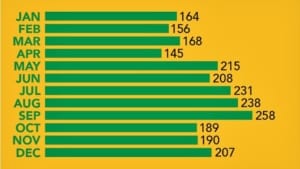
Apparently, there are several types of alcoholics.
Scientists at the National Institute on Alcohol Abuse and Alcoholism (NIAAA) conducted a survey of 43,093 individuals, screening them for alcohol dependence as well as a wide range of other factors. The NIAAA researchers found that there were five distinct patterns of alcohol dependence.
YOUNG ADULT SUBTYPE
This is the most prevalent subtype, making up 31.5 percent of people who are alcohol dependent. The average age of dependent young adults is 25 years, and they first became dependent at an average of age 20. They tend to drink less frequently than people of other types (an average of 143 days a year). However, most of their drinking is binge drinking – they drink five or more drinks on an average of 104 (73 percent) of those days. On drinking days, the average maximum number of drinks is 14. This pattern of alcohol use is more likely to be hazardous than non-binging patterns.
Young adult alcohol dependents are 2.5 times more likely to be male than female. About 75 percent have never been married, 36.5 percent are still in school, and 54 percent work full time. Approximately 22 percent have a first- or second-degree family member who is also dependent on alcohol. Compared to other types of alcoholics, young adults are less likely to have psychiatric disorders or legal problems. Fewer than 1 percent of them have antisocial personality disorder. About 32 percent also smoke cigarettes, and 25 percent also use cannabis.
Only 8.7 percent of young adult alcohol dependents have ever sought treatment for their drinking problem. If they do choose to seek help, they tend to prefer 12-step programs over specialty treatment clinics or private professional practices.
The NIAAA reports that four out of five college students drink alcohol and half of those who do binge drink. They also note that each year, among college students between the ages of 18 and 24:
- At least 1,825 students die from alcohol-related accidental injuries.
- Over 690,000 students are assaulted by another student who has been drinking.
- More than 97,000 students are victims of alcohol-related date rape or sexual assault.
- About 599,000 students are unintentionally injured while they are under the influence of alcohol.
- Over 150,000 students develop alcohol-related health problems.
- About 25 percent of students experience school-related consequences from their alcohol consumption, such as being late to or missing classes, falling behind on coursework, doing poorly on homework, exams or papers, and receiving overall lower grades.
YOUNG ANTISOCIAL SUBTYPE
Young antisocial alcohol dependents make up 21.1 percent of alcoholics – 54 percent of them have antisocial personality disorder (ASPD). ASPD is characterized by at least three of the following:
- Recurring criminal activities
- Regular fights or assaults
- Lack of regard for the safety of others
- Lack of remorse
- Impulsiveness
- Deceitfulness
- Irresponsibility
They are also young (average age 26 years), and they have the earliest age of onset of drinking (average 16 years) and the earliest age of alcohol dependence (average 18 years). Young antisocial alcoholics drank an average of 201 days in the last year, binge drinking (consuming five or more drinks) on an average of 161 (80 percent) of those days. When they drink, their maximum number of drinks is 17, the highest of any subtype of alcoholic.
About 76 percent of this type of alcoholic are male. Only 7.6 percent have received a college degree, although another 13.4 percent are still in school. Approximately 47 percent are employed full time. Family incomes average around $32,000, the lowest among the subtypes (alongside the chronic severe subtype).
Over half of young antisocial alcoholics (52.5 percent) have a close family member who is also alcohol dependent. In addition, they also have high rates of psychiatric disorders:
They also have high rates of substance abuse:
Almost 35 percent of young antisocial alcoholics have sought help for their alcohol-dependence problems. They tend to go to self-help groups, detoxification programs, and specialty treatment programs, and they have high rates of participation in treatments offered by individual private health care providers.
The NIAAA reports that alcohol and ASPD make for a dangerous combination. People with ASPD are 21 times more likely to develop alcohol dependence in their lifetimes. Meanwhile, alcohol is more likely to increase aggressive behaviors in people with ASPD than in people without. This may be because alcohol interferes with executive functioning in the brain, which regulates and inhibits aggressive behavior. People with ASPD also show impaired executive functioning, which may make them particularly vulnerable to this effect.
FUNCTIONAL SUBTYPE
Functional alcoholics make up 19.4 percent of alcohol-dependent individuals. This group tends to be older (average age 41 years), has a later age of first drinking (average 19 years), and a later onset of alcohol dependence (average age of 37 years). They tend to drink alcohol every other day (an average of 181 days per year), and they consume five or more drinks on an average of 98 (54 percent) of those days. On drinking days, they tend to consume a maximum of 10 drinks.
About 62 percent of functional alcoholics work fulltime, 3.6 percent are in school fulltime, and 5 percent are retired. Nearly 26 percent have a college degree or higher, and average household income is almost $60,000, the highest among any of the subtypes. Approximately 40 percent are female, and nearly 50 percent are married.
About 31 percent of functional alcoholics have a close family member who also has alcohol dependence. They have moderate rates of major depression(24 percent) and smoking cigarettes (43 percent), and low rates of anxiety disorders, other substance use disorders, and the lowest rates of having legal problems (fewer than 1 percent). Fewer than 1 percent of these individuals have antisocial personality disorder.
Only 17 percent of functional alcoholics have ever sought help for their alcohol dependence. Those who do tend to make use of 12-step programs and private health care professionals. Functional alcoholics make up 19.4 percent of alcohol-dependent individuals. This group tends to be older (average age 41 years), has a later age of first drinking (average 19 years), and a later onset of alcohol dependence (average age of 37 years). They tend to drink alcohol every other day (an average of 181 days per year), and they consume five or more drinks on an average of 98 (54 percent) of those days. On drinking days, they tend to consume a maximum of 10 drinks.
INTERMEDIATE FAMILIAL ALCOHOLICS
Intermediate familial alcoholics make up 18.8 percent of all alcoholics. Nearly half (47 percent) of them have a close family member who is also an alcoholic. They have an average age of 38 years, began drinking at almost age 17, and developed alcohol dependence at an average age of 32 years. Intermediate familial alcoholics drink on an average of 172 days a year, consuming five or more drinks on 93 (54 percent) of those days, with a maximum of 10 drinks.
They have the highest rates of employment among alcoholics, with 68 percent working full time and with an average family income of nearly $50,000 a year. Nearly 20 percent have a college degree. About 64 percent are male, while about 38 percent are married and 21 percent are divorced.
Intermediate familial alcoholics have elevated rates of mental illness:
They also have higher rates of substance use/abuse:
- 57 percent smoke cigarettes
- 25 percent have cannabis use disorder
- 20 percent have cocaine use disorder
Almost 27 percent of intermediate familial alcohol dependents have sought help for their drinking problem. They tend to prefer self-help groups, detoxification programs, specialty treatment programs, and individual private health care providers.
CHRONIC SEVERE SUBTYPE
This is the rarest and most dangerous type of alcoholism, making up 9.2 percent of alcoholics. Chronic severe alcoholics average 38 years of age. They begin drinking early (at 16 years) and develop alcohol dependence later (around 29 years of age). This group has the highest rates of drinking, consuming alcohol on an average of 247.5 days a year and binge drinking on 172 (69 percent) of them, with a maximum of 15 drinks.
The majority of chronic severe alcoholics are male (65 percent). They also have the highest divorce rates, with 25.1 percent divorced and 8.6 percent separated, and only 28.7 percent married. Only 9 percent have a college degree, and they also have the lowest employment rate, with only 43 percent of chronic severe alcoholics employed full time and 7.6 percent both unemployed and permanently disabled.
Chronic severe alcoholics have the highest rate of family members who also experience alcohol dependence, at 77 percent. They are most likely to have mental illnesses:
- 55 percent have depression
- 47 percent have antisocial personality disorder (the second-highest rate, after young antisocial alcoholics)
- 34 percent have bipolar disorder
- 26 percent have social phobia
- 25 percent have dysthymia
- 24 percent have generalized anxiety disorder
- 17 percent have panic disorder
Substance abuse is also common:
- 75 percent smoke cigarettes
- 58 percent have cannabis use disorder
- 39 percent have cocaine use disorder
- 24 percent have opioid use disorder
Chronic severe alcoholics experience the most pervasive symptoms:
- Highest rate of emergency room visits related to drinking of any subtype
- 94 percent drink larger/longer amounts than intended
- 92 percent drink despite experiencing problems from drinking, such as at work, school, in relationships, or while driving
- 88 percent experience withdrawal symptoms
- 83 percent have repeatedly tried to reduce their drinking
- 64 percent spend significant time recovering from drinking
- 48 percent reduced meaningful activities, like hobbies or family time, because of alcohol
Almost 66 percent of chronic severe alcoholics have sought help for their alcoholism. They have the highest rates of attendance at self-help groups, detoxification programs, and specialty rehabilitation programs, and the highest rates of treatment in inpatient programs. When seeking treatment, they tend to turn to social workers, psychologists, psychiatrists, and private physicians.
Alcoholism is a debilitating disease. Making matters worse, it can lead people to commit crimes they otherwise would not commit. DUI is the perfect example of a crime which necessarily involves alcohol or drug abuse. Fortunately, there are defenses. Voluntary Intoxication and/or Diminished Capacity might apply. Please contact my office if you, a friend or family member suffer from alcoholism and are charged with a crime. Perhaps good defenses combined with hard work and strong dedication to a alcohol treatment program might persuade the Prosecutor to reduce or dismiss the charges.
Please contact my office if you, a friend or family member are charged with a crime. Hiring an effective and competent defense attorney is the first and best step toward justice.
















